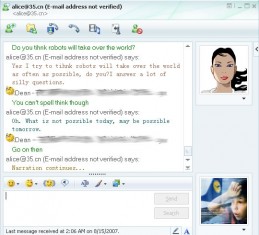Chatbots 3.0 | 3rd Colloquium on Conversational Engines
February 21, 2010

Dean Lee from www.deanlee.cn
Please join us for: Chatbots 3.0 | Third Colloquium on Coversational Engines. Bot creators, commercial users, enthusiasts, scientists, students, and the press are all invited.
Saturday, March 27, 2010: Suite 3200 (32nd Floor) Liberty Place, 50 S. 16th Street, Philadelphia, PA 19102
Why Chabots 3.0? | Chatbots have been adapted to nearly every ecological niche on the internet. Bots appear on web pages, in instant messaging, and respond to email and forum posts. They can be found in Second Life, in online games, and in social networks such as Facebook and Twitter.
Bots support marketing and advertising and are used in education. This conference brings together leading experts to discuss their ideas and present the latest technologies and trends in chatbots.
Artificial intelligence chat bots, also known as chatterbots or conversational agents, developed in a series of three stages over the past 60 years.
The First Wave | Alan Turing conceived of the talking computer in his 1950 paper, Computing Machinery and Intelligence. For his famous test, Turing imagined an artificial intelligence that communicates in natural language through a text based medium, such as a teletype.
In 1966 MIT Professor Joseph Weizenbaum became the first botmaster, or chat bot author, when he created the famous ELIZA prorgam. ELIZA was the first A.I. to apply the concept of stimulus-response pattern recognition to natural language understanding. ELIZA was also the first bot to employ conversational logging as a means for the botmaster to review and refine the bot.
Dr. Hugh Loebner began sponsoring the first real-world Turing Test in 1991. To the surpise of many, the winner of the first contest was based on the ELIZA psychiatrist program.
In 1994, Michael Mauldin created a bot named Julia in an online MUD environment. He coined the term “chatterbot” to describe his conversational programs.
The Second Wave | The advent of the world web marked the beginning of widespread access to chatterbots. By exposing their bots on the web, botmasters collected a huge amount of conversational log data to help them improve the quality of the bots. Better and faster computers led to the development of large knowledge bases for bots.
Dr. Richard Wallace launched the free software ALICE project in 1995. ALICE led to the development of the open AIML standard for creating chat bots. An alphabet soup of AIML interpreters and servers appeared.
The first commercial chat bot companies, Neuromedia and Virtual Personalities, were launched in the heady early days of the dot-com boom.
In the late 90’s, two prominent web sites emerged to provide to index and promote chat bot projects and companies. These were the Simon Laven page, and Marcus Zillman’s Botspot.com.
The Third Wave | Today chatterbots have been adapted to nearly every ecological niche on the internet. Bots appear on web pages, in instant messaging, and respond to email and forum posts. They can be found in Second Life, in online games, and in social networks such as Facebook and Twitter. Bots support marketing and advertising and are used in education.
New technologies for automated learning have appeared which vastly reduce the time and effort needed to create convincing bots. At the same time, a series of new commercial opportunities have opened for bots and their botmasters.
We’re experiencing the beginning of a new era. The time has come to gather together the leading experts in chat bot technology to share our ideas and discoveries.